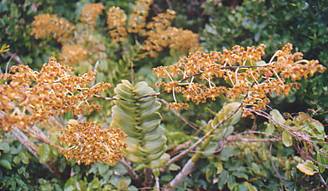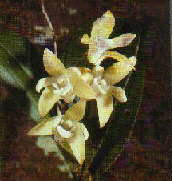Return to Understorey
OR
Return to Rainforest Plants\Trees
Rainforest Orchids 
Photo: Courtesy of Damon Ramsey
BSc.(Zool) Biologist Guide
Rainforest Orchids: The orchid family is a group of very hardy plants that are very abundant in the wild. They belong to the family Orchidaceae, which is claimed by some authorities to be the largest of the plant families. There are some 230 species of orchids found in the Wet Tropics of Queensland. This is between one-quarter and one-third of Australia's orchids. Their evolution has enabled them to live in a variety of niches including growing on trees (epiphytes), rocks (lithophytes) and in the ground (terrestrials). Some species have lost their chlorophyll and ability to derive energy from sunlight. This means they must rely on are saprophyte fungi to provide food. Orchids are characterised through their ways of animal pollination and wind dispersal and their adaptations to these to give them their common features. The pollen grains are massed into discrete parcels called pollinia to help with efficient pollination as the parcels are easily carried around by insects. The orchid flowers have evolved to entice the insect into doing this. The flower is made up of three sepals which are similar to each other and arranged radially, and three petals, one of which is modified to act as a landing pad for insect pollinators. The female and male parts in the centre of the flower are fused into a column with a single anther at the end. Some species have a lip designed to mimic a female insect and attracts males to try to mate with it. The colours, shapes and scents used to attract insects are numerous. Ranked among the world's most attractive species is the Cooktown Orchid. It has large pink coloured flowers - a common sight in the Cape York Peninsula monsoon scrubs. Orchids are abundant from Townsville to Cooktown in areas of rainforest, open forest, mangroves, mountain tops and even eucalypt-dominated forests. This diversity in habitats has resulted in the rich diversity in orchids. Because of the widespread interest in orchids, they are collected by many people, sometimes resulting in significant decreases in numbers of orchids. They will need to be protected, which can be afforded to some extent by National Parks and the World Heritage Area, but it must be recognised that simply declaring an area as a National Park will not be fully protect the plants in it. Growing native orchids is fine, but there are some rules that should be followed: - 1. be aware of the legislation regarding collecting from the wild; 2. do not collect unless you have permission from the land owner; 3. only collect from areas which have been or are to be cleared; 4. never buy orchids unless satisfied they were obtained legally; 5. do not collect plants that you do not have the expertise or conditions to successfully grow them; 6. do not collect more than you need for yourself. In the Wet Tropics upland rainforests, large epiphyte orchids occur on the larger trunks and forks, but the real diversity is often in the small branches of the outer canopy. Terrestrial species such as the jewel orchid may be abundant on the forest floor where there are rocks, on slopes where there is good drainage, or on the banks of small streams. A few of the many orchid species found in the Wet Tropics include the Apricot Orchid, Pink Fingers, Jewel Orchid, Christmas Orchid, Leafless Nodding Orchid, Northern Tangle Orchid, Tableland Pencil Orchid, Charging Bull Orchid, Fairy Bells and King Orchid.
Additional Information: Courtesy of Damon Ramsey Many botanists believe it to be one of the most highly evolved plant families, and there are indeed many species that have elaborately specialised relationships with particular pollinating insects. They are important to humans for various other reasons; for example, the flavour vanilla comes from an orchid. It is also one of the celebrated families, for the spectacular, elaborate flowers are prized by flower fanciers all over the world. The flowers are often spectacular in the fact that they are often colourful, or intricately patterned, and the uneven (zygomorphic) petal arrangement often forms bizarre shapes. These are made from three sepals; two lateral sepals that stick forward, and a high dorsal sepal, and three petals; two lateral petals that stick out like wings, and the front hanging petal called the labellum that hangs out like a tongue (Clarke and Lee 1997). The resulting fruits are usually small, hard, dull capsules. The plants themselves are usually only small, growing either as tiny ground herbs, or compact bunches growing on trees or rocks. Orchids are found practically over the world. However, they are much better known, and there are many more species, in the tropics, where they grow mainly as epiphytes high in the rainforest canopy.
Script: Courtesy of Damon Ramsey BSc.(Zool) Biologist Guide 
Photo: Courtesy of C & D Frith
Australian Tropical Rainforest Life
|
